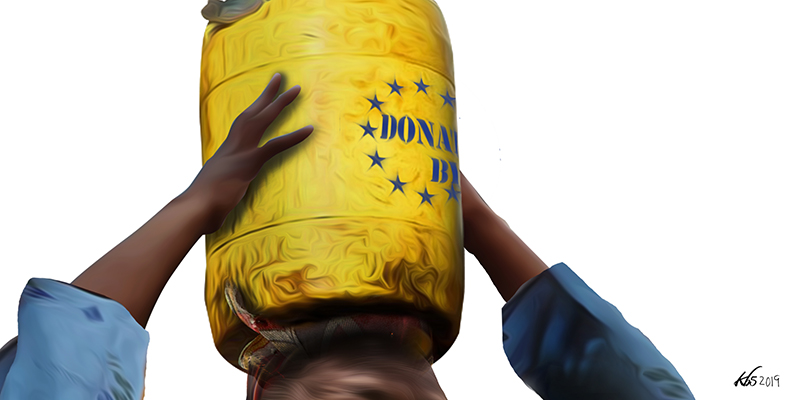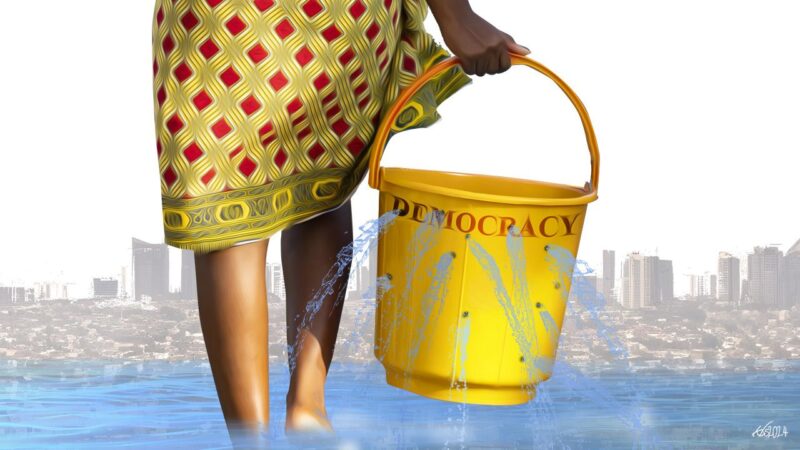Despite lacking in the environmental conditions necessary to grow many of the world’s most valuable commodities, Europe dominates the global commodity trade. Data shows that Switzerland, despite being a relatively minute and landlocked country bereft of any major ports and far from key trading routes, leads the way in transit trading for coffee, sugar, metals, grains and crude oil (one third of globally produced oil is controlled by companies headquartered around Lake Geneva alone).
Through the import and subsequent re-export of raw commodities from Africa and the rest of the Global South, a number of European countries have managed to establish hugely profitable commodity export industries, despite the lack of any obvious natural comparative advantage in the sector. Recent research, focusing on the coffee market, has found that a sample of leading European re-exporting countries earned an average of over $300 per standard bag of coffee exported between 2000 and 2010, compared to only $106 in a sample of leading low-income coffee producing countries, all located in the Global South.
Given that many African countries still tend to rely heavily on their natural resource exports for domestic employment, foreign exchange earnings and tax revenues, the concentration of commodity export profits in Europe is a major cause for concern. Research calculated that developing countries lose approximately £8 billion a year from irregularities in commodity trading prices with Switzerland alone. Considering that such a figure would be considerably higher if it included the host of other successful European commodity re-exporters, such as Germany, Belgium, France, Italy and the UK, the purpose of this article is to explore why such a counter-intuitive dynamic persists in the commodity sector, long after the colonial era of resource exploitation is said to have ended. I argue that European states have actively promoted the intense concentration of their commodity trading multinationals and have simultaneously pressured developing countries into liberalising and fragmenting their own commodity export industries.
Given that many African countries still tend to rely heavily on their natural resource exports for domestic employment, foreign exchange earnings and tax revenues, the concentration of commodity export profits in Europe is a major cause for concern.
Based on re-export data published by the International Coffee Organisation, it is apparent that European countries earn over three times more from the export of coffee products than countries in Africa. Whilst the sample of developing countries included in the study discussed here encompassed all major regions in the Global South, three were included from Africa. Between 2000 and 2010, Ethiopia, Uganda and Côte d’Ivoire received an average of $138, $71 and $68 per bag of coffee exported, respectively. Switzerland, Europe’s most profitable coffee re-exporter, earned over $700 per bag. However, other European countries, such as the UK and Italy, also earned more than double per unit exported than the best-performing African country studied, Ethiopia. In terms of total value earned, Germany’s coffee export industry eclipsed that of any of the three African countries studied, despite the fact that all three are leaders in terms of coffee export volume in the African context.
In 2009, the International Coffee Organisation’s annual review showed that coffee added $31 billion to the economies of the nine leading coffee importing nations, twice as much as the total export earnings of all coffee producing nations. Whilst coffee is but one example, it, by itself, is an essential commodity for a number of African states and many livelihoods depend on it for subsistence. In four African countries, coffee exports account for more than a fifth of total exports (Uganda, 20%, Burundi, 23%, Rwanda, 27%, and Ethiopia, 32%). This not only impacts the millions of small-scale African coffee producers, their families and communities, but also African economies as a whole, as the state is heavily dependent on tax revenues from these industries. Rwanda, for example, raises 70% of its total tax revenue from multinationals, with nearly half of its revenues coming from just 0.3% of its taxpayers. For Nigeria, multinationals represent 88% of its tax base, whilst one multinational tax payer, alone, contributes to 20% of Burundi’s.
The “value-added” narrative
Given the developmental implications of a highly unequal distribution of value in commodity trading markets, it is critical to understand why such a disparity between the export earnings of coffee producing and re-exporting countries exists. The problem here is not solely a case of European countries being more competitive in the higher-value adding activities along commodity value chains, as is often claimed. This traditional “value-added” narrative is based on the idea that the majority of the value in a final cup of coffee sold in a European coffee shop is primarily derived from retailing, marketing and more advanced processing activities, such as roasting or decaffeinating. The majority of these activities take place in re-exporting countries and are undertaken by Northern multinationals. However, the basis for the calculations that underpin this value-added assessment is inherently flawed.
According to John Smith’s The GDP Illusion, traditional GDP calculations can paint a distorted picture of where value is generated. In many key value chains, that produce goods, such as the T-shirts, iPhones and cups of coffee, value is “captured” by imperialist re-exporting countries in the Global North, rather than “added”. Such a distinction is important because it suggests that the disparity in export earnings is more likely the result of severe imbalances in power relations between the key actors in coffee producing and coffee re-exporting countries, rather than the technical superiority of Northern multinationals in performing more advanced and profitable “value-adding’” activities.
Rather than taking the traditional approach of questioning how African countries can become more internationally competitive in advanced coffee processing activities, the key question is how to address the severe power imbalances between coffee producers and coffee buyers and between coffee processors and traders. To do so, it is essential to understand how these imbalances have developed and which actors have been driving such developments. Evidence seems to suggest that active policies implemented by European states during the 1980s and 1990s contributed to dramatically restructuring global commodity markets in their favour by artificially inflating the international competitiveness of their commodity trading and processing industries. In the 1970s, around 20% of total earnings were retained in coffee growing countries, compared to 53% staying in the re-exporting and consuming countries. By the end of the 1990s, this had changed to 13% versus 78%.
Rather than taking the traditional approach of questioning how African countries can become more internationally competitive in advanced coffee processing activities, the key question is how to address the severe power imbalances between coffee producers and coffee buyers and between coffee processors and traders.
Monopoly capitalism
European re-exporting states, at best, allowed and, at worst, promoted, the consolidation of their commodity trading multinationals. This consolidation has further extended the power advantage of these firms in price negotiations with smallholder coffee farmers in producing countries. Monopoly capitalism has been used to describe this growth of increasingly powerful multinational monopolists in imperialist countries who have close connections to their states and use their power advantages to manipulate prices and inflate their own profits and the GDP statistics of their home countries.
In the early 1990s, five traders controlled the lion’s share of coffee imports into the major consuming countries, all of whom were based in Europe or the United States. By the 2000s, mergers and acquisitions had led the market to become even more concentrated, with just three firms dominating, all of which were European. In the processing sector, the share of the five largest firms more than doubled between 1995 and 1998, from 21.5% to 58.4%. At the very end of the chain, the market share of the five largest grocery retailers in 16 European countries eclipsed 80% by 2000.
Susan Newman, in her work on the effects of financialisation on the coffee market, says that “the trend has been towards the concentration of a few large coffee traders, many of which have merged with other commodity traders to become very large multinational commodity trading companies”. She goes on to state that the “concentration of the top five companies has also increased since 1998, and now accounts for a market share of over 55 percent”. Whilst technological and communication advancements no doubt eroded trade margins and created conditions that favoured the largest international corporations, the reluctance of European states to take action against the increasing monopolisation of their commodity industries is indicative of the shared interests between these states and their commodity multinationals. It is no coincidence that Switzerland, the most profitable commodity re-exporter, also has a merger policy which is incredibly weak, unaccountable and easily-influenced.
Research by Thomas Zweifel compared the best and worst practices of US, European Union and Swiss merger policies in the early 2000s and found that “unlike under US or European rules, responsible persons cannot be prosecuted. Sanctions against Swiss cartels cannot be imposed retroactively: no fines equivalent to the economic damage can be imposed. Penalties can be imposed only if a monopoly has been certified as illegal and continues nonetheless”.
Further, the Swiss merger policy is “neither very accountable nor very independent”, with its competition commission officials appointed by the executive rather than the legislature. It also reports primarily to the economics ministry and is not required to seek public participation, publish its decisions or even give reasons. In turning a blind eye to the consolidation of its largest multinational commodity firms, the Swiss state has artificially inflated its international competitiveness through enhancing the power of its commodity trading multinationals in price negotiations with foreign producers and through allowing them to enjoy such significant economies of scale that it makes it nearly impossible for low-income countries to compete in any of the more advanced and profitable activities along the value chain.
Whilst the Swiss case is the most extreme example of weak competition policy, the shocking degree of concentration that has been allowed to develop in commodity trading, processing and retailing industries across Europe in the neoliberal period partly explains why coffee re-export statistics show that many other European countries, albeit to a lesser extent, are still far more profitable re-exporters than even the leading African coffee producers.
Dismantling cooperatives
The 1980s and 90s also saw important developments in the coffee markets of producing countries. Between the end of World War II and the 1980s, intervention in coffee markets was commonplace and emphasised the stabilisation of export prices through multilateral agreements. Various International Commodity Agreements (ICAs) between 1954 and 1989 established an international minimum price maintenance system, whilst the majority of domestic coffee markets in many ex-British African economies had marketing boards (as well as in Angola, Ethiopia and Togo). Ex-French economies were also similarly structured, with “Caisse de Stabilisation” being the Francophone equivalent.
These boards were responsible for buying coffee, setting prices, regulating quality control and, most importantly, acting as an intermediary between smallholder coffee producers and global traders, coordinating the sale of coffee through auctions. Thus, these marketing boards negotiated prices and the terms of the export arrangements of coffee to trading multinationals (often European) but, as a result of the structural adjustments of the early 1990s, the majority of these boards were dissolved rather than reformed. It should be noted that not all African countries embraced the restructuring of their commodity export markets to the same degree. Whilst Uganda fully liberalised its coffee market by 1991 and completely eradicated its cooperatives, Tanzania only begun partial liberalisation in 1994 and retained a state-run coffee auction system. However, the general pattern across Africa has been the dismantling of varying forms of coffee export cooperatives.
The result of this restructuring was to further fragment the coffee industries in producing countries. At the same time as European buyers were becoming more concentrated, smallholder coffee farmers were being forced to negotiate as individuals, rather than as collective national industries. Karin Wedig and Jörg Wiegratz, in their work on cooperatives in Uganda, point out that despite the fact that cooperatives in the pre-neoliberal era often had problems with inefficient management that meant that below-market-prices were frequently paid to producers and that there was generally low investment in infrastructure, cooperatives are ultimately necessary to address power imbalances in the market. “Through bulk sales, as well as the pooling of resources to access processing technology and services, cooperatives can strengthen smallholders’ capacities to compete with large producers, because buyers are more willing to engage in direct negotiations if farmers can offer larger output volumes at constant quality.”
The result of this restructuring was to further fragment the coffee industries in producing countries. At the same time as European buyers were becoming more concentrated, smallholder coffee farmers were being forced to negotiate as individuals, rather than as collective national industries.
Furthermore, they found that farmers in Uganda enjoyed significantly higher prices during the years when the cooperative studied was revived, an effect that was reversed in 2011 when the state intervened to limit the cooperatives’ operations once again. Whilst lax competition policy in re-exporting countries enhanced the power of commodity buyers, the dismantling, rather than reform, of cooperatives in producing countries reduced the power of commodity growers, which has fostered a situation of severe power imbalance in the market and explains the significantly higher returns enjoyed by coffee re-exporting countries.
The concentration of European commodity trading and processing industries alongside the atomisation of commodity producing industries in Africa and much of the rest of the Global South has restructured the global commodity trade to favour European countries, to the detriment of the rest, an assertion supported by leading research into the coffee industry.
These twin developments are often attributed to natural changes in the market, but European states have certainly played a role in facilitating these developments through active policy. The negligent approach of the European Union and certain individual European nations to anti-trust policy and to the breaking up of their commodity monopolies is a clear indicator of this, whilst it should not be forgotten that they also helped promote the atomisation of commodity export industries in producing countries through their promotion of global neoliberal restructuring through international financial institutions.
The role of European states as the handmaiden of the monopolistic commodity multinationals has generated criticism from the development community, as well as accusations of hypocrisy for adopting policies that undermine development while at the same time as “sacrificing” sizeable public funds to development aid. So far, it appears that these concerns have largely been ignored. Apparently with Margathe Vestager as the new European Competition Commissioner, the EU now has a “trailblazer in regulating big tech and business”, according to the Financial Times. However, this newfound regulatory zeal does not seem to apply to the mega-mergers taking place in commodities industries. Of the 24 mergers that the European Community has formally prohibited since 1990, none have related to coffee or any of the other major commodities.
Existing research does not seem to explain why this is the case, which highlights the need to delve further into the politics of competition policy in the EU and other the major imperialist re-exporters. With the destructive effects of concentration in commodity industries in these countries now abundantly clear, attention must be turned to holding responsible parties to account and reversing these trends.
Editors Note: This article was first posted in the Review of African Political Economy (ROAPE)








